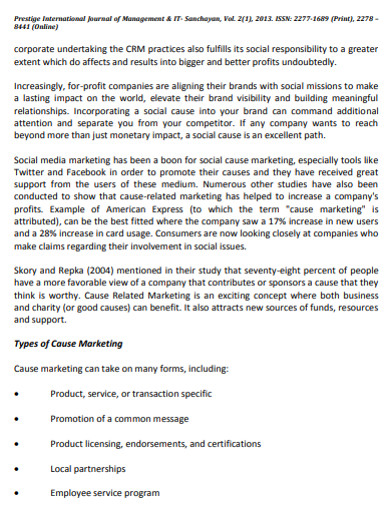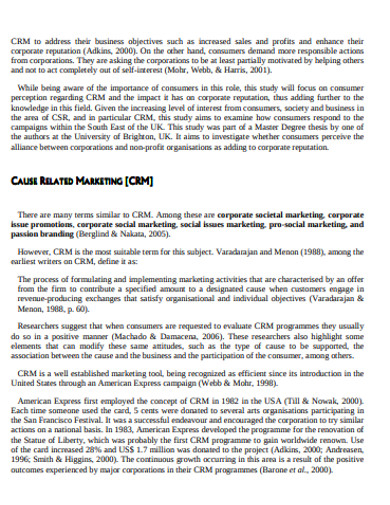9+ Cause Marketing Examples to Download
Doing something good for the community puts a company in a good light. Cause marketing isn’t like philanthropy that generously gives back for the common good. It is a corporate marketing strategy that gives and takes. And successful campaigns do these so effectively that the whole thing doesn’t feel like it’s just an insincere, cash-grabbing ploy. Since consumers want to buy from brands that promote social and environmental accountability, your company needs to learn about cause-related marketing.
What Is Cause Marketing?
Cause marketing is a marketing strategy that seeks to improve consumer engagement, brand identity, and company revenue. It works because people want to make a difference, even in small things. If your company allows its audience to have a socially and environmentally conscious choice, people will gravitate towards your goods and services. When you do your cause-related marketing campaigns right, you have sales opportunities, and you promote brand visibility and loyalty, a distinction among the competition, and a revamped company image.
Brands Who Did It Right
Walk With Purpose
In the US, a woman has a 13 percent chance of developing breast cancer in her life. This form of cancer is still claiming the lives of several thousand. Since 2007, Avon company has partnered with Reebook to raise awareness and money for cancer research. Reebook is the official footwear and apparel sponsor for the annual Avon39 Walk to End Breast Cancer. The goal is to raise millions for research into the prevention and treatment of the disease.
The No-Ad Ad
When Typhoon Haiyan hit the Philippines in 2013, it affected more than 14 million people in the area and cost $225 million in agricultural damages alone. The world came to the country’s aid. There were big companies that helped, but Coca-Cola made the most ripples. The company announced that it would suspend brand advertising in the country and use the money instead for relief aid. The company also donated $2.5 million in cash and kind.
An Ad to Buy Less
Black Friday and Cyber Monday deals entice people to buy more for less. It is an effective seasonal marketing strategy for companies to schedule sales during these dates. In 2011, Patagonia thought differently. In their Common Threads Initiatives, they campaigned for consumers to buy less, citing the environmental cost of production. In a message of quality over quantity, the company gave the customer a conscious choice and also communicated the quality of the brand’s merchandise.
Multiple Choices
Aside from direct charity donations and volunteer work, you can also consider the following marketing strategies:
Customized Products
You can put up products that you specifically designed for charity. The proceeds will be given to the sponsored organization. You can do what a local bookstore in the Philippines did. National Bookstore prepared packs of children’s school supplies and sold the items in stores, but the customers do not bring them home. The bought items will be collected and donated to schools. This way, the customers are passively participating in the act of corporate philanthropy.
Crafted Souvenirs
You can also design products that the customers can keep and use after they have donated to your chosen cause. It can be personalized umbrellas, totes, shirts, and bags. You can sell these items and give a fraction to charity. You can also provide them for free after the people donated, as tokens of appreciation. It will help spread the message of supporting the cause and give publicity for your brand.
Create A Fundraiser
Your company can also host a fundraising event like games, shows, concerts, or auctions. You can invite famous personalities that will draw more crowds into your event. A concert would be a big hit for the musical millennials. You can advertise the cause on social media pages as well as in the ticket designs. You can give profit from the tickets to the chosen nonprofit organizations. Note that your event must align with the consumer understanding of your company.
10+ Cause Marketing Examples
The following are examples of cause marketing that can help you in your campaigns.
1. Cause Partnership Marketing Example
2. Sample Cause Marketing Example
3. Cause Marketing Strategy Example
4. Cause Transparent Marketing Example
5. Cause Marketing Proposal Form Example
6. Cause Social Marketing Example
7. Formal Cause Marketing Example
8. Cause Sales Marketing Example
9. Printable Cause Marketing Example
10. Simple Cause Marketing Example
11. Sample Cause Marketing in PDF
How to Get Started with Cause Marketing Campaigns
The best cause marketing campaigns weren’t thought overnight. The marketing team underwent serious brainstorming and planning. Here are some tips on how to deliver an effective campaign:
Step 1: Choose a Cause
The first thing you have to consider is what causes would align with your brand image. A cause that is far from the company’s identity makes the entire endeavor seem insincere. You also have to see to it that your employees would support it, too, since they would be involved in the process. Look for a cause that fits with the brand and your marketing campaigns will feel genuine to your customers.
Step 2: Set a Timeframe
Supporting a cause is a noble goal for a company. A successful cause marketing campaign would require time and resources. You have to plot a schedule for the activities and set a proposed budget. You can use Gantt charts in setting up time frames so that you can also monitor the progress of each task. Create a budget plan as well so that you can oversee the ins and outs of resources. Be it personal or business venture, it’s only smart to plan.
Step 3: Establish Success Criteria
When you set out on a project, how will you determine if it was successful or not if you have not defined what success means? It can mean increased monthly revenue or an additional 30% website visits, as long as it’s not vague. Determine the campaign objectives and monitor the progress throughout to see if the company has achieved its goals. A success criterion objectively measures the value of your marketing campaign.
Step 4: Partner With Orgs
Pairing with nonprofit organizations is a practical way to get started with cause marketing. Still, the mission of the org should fit with your company’s image. You can start with organizations in the local community which need support. With the partnership, you can raise awareness about the issue they’re addressing, and you also gain exposure and a fresh face in the market. You could, as well, get new customers who share the org’s interest.
Step 5: Think Out the Box
Don’t just set up donation boxes and collect money directly. People generally don’t pay attention to a box in the corner. Be creative with your cause marketing campaign and make it memorable. You can sell a pair of shoes, or a pack of school supplies and a portion of the profit will be given to the cause. Think of something that would make your brand stand out for all the right reasons. The best example is Patagonia’s 2011 Common Threads Initiative mentioned earlier.













